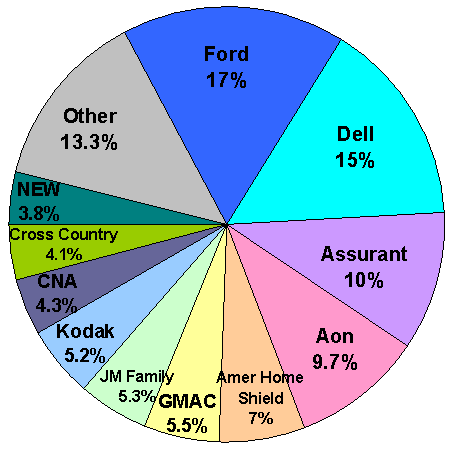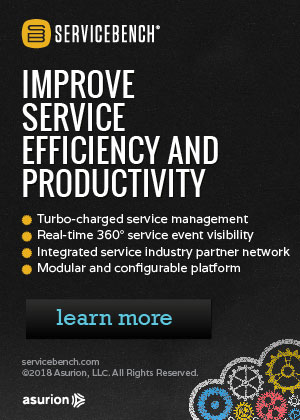Extended Warranty Administrators:
While auto and PC manufacturers have the top spots, insurance companies and third party administrators grab the bulk of the pie.
At long last, the pie is ready. It's taken almost four months to conclude our travelogue of the extended warranty industry with a graphic depicting the size of the industry and the major players in it. By the amount of email requesting extended warranty market numbers, this pie is hopefully being delivered right on time.
Just as in previous editions we've sized the product warranty industry to be in the neighborhood of $25 billion per year, in this edition we're suggesting that extended warranties generate in the vicinity of $15 billion per year in premiums paid. Not all that money goes to the actual administrators and underwriters of the policies, however. In fact, we're estimating that roughly half is kept by the actual sellers -- the retailers and dealers in the world of warranty. Only $7.5 billion passes through to the administrators, we estimate.
Now here's the problem. Some of the market participants are seller, administrator, and underwriter wrapped all into one. Others are both administrator and underwriter. And still others are underwriters only, or administrators only. We don't want to miss any money flowing through the extended warranty industry, but we also don't want to double-count any premiums paid.
Administrators Only
The charts below list only the administrators. Or more precisely, they list independent administrators, sellers/administrators/underwriters, and administrators/underwriters. Missing from the list are underwriters-only such as the American International Group Inc. (AIG). The Great American Insurance Group, which stands behind administrators such as NEW, Warrantech, and the Warranty Corporation of America, also owns an auto warranty administrator called Premier Dealer Services Inc. Also included are dual administrators/underwriters such as the Assurant Group and the Aon Warranty Group. Perhaps in Version 2.0 we'll include three pie charts: for sellers, administrators, and underwriters.
Readers who for one reason or another are reading Warranty Week without graphics can take a look at the online edition at http://www.warrantyweek.com/newsarchive/ww20050119.html or at the missing pie chart at http://www.warrantyweek.com/library/ww20050119/admin.gif. A reader of the plain text edition reported that the charts in the past two weekly columns were rendered unreadable by his email program. Readers with similar problems can email the editor for copies of the PowerPoint and Excel files used to create this week's graphics. All readers are invited to comment or criticize this work, which we present to you as simply Version 1.0 of an ongoing project.
Extended Warranty Administrators
Estimated Market Shares, 2004
Version 1.0

Total = $7.5 billion
Source: Warranty Week
The big surprise is probably the companies with the largest slices of the pie. Of course, these are estimates, but we're estimating that Ford and Dell are the only two companies bringing in more than a billion dollars a year through the sale of extended warranties. We don't think there is a third. And we're using their own disclosures to arrive at those estimates. In the fiscal year ended Jan. 31, 2004, Dell reported $912 million in recognized income from the sale of extended warranties. For the first six months of fiscal 2005, the company reported $585 million in recognized revenue. It doesn't take a degree in astrophysics to multiply that figure by two and add a bit for good luck.
The Ford estimate is more open to debate. The company hasn't mentioned extended warranties in its quarterly financial statements since way back in the first quarter of 2003. Back then, perhaps inadvertently, the company disclosed that it recognized $299 million in extended warranty revenue during the quarter. Once again, it isn't rocket science to multiply that figure by four to arrive at an annual amount. And remember, what we're saying here is that even if there's been no growth at all for Ford or its subsidiary Automobile Protection Corp. in the past seven quarters, it's still the biggest player around when it comes to the sale of extended warranties. We just didn't think anybody would believe that a company could hide $1.2 billion in insurance sales and be the biggest player in a business few people know they're even a part of.
Actually, it makes perfect sense that the largest players in the extended warranty business are manufacturers from the passenger car and computer industries. These are the largest slices of the product warranty business too, accounting for 40.5% and 20.5% of the pie served in last week's edition of Warranty Week. Interestingly, Ford and Dell also are the respective number two players in those sectors to GM and HP. In this pie, things are different.
Insurance Companies
Somewhat smaller slices are assigned to the well-known major players. Assurant and Aon are virtually tied for third and fourth place. If we were to set aside the manufacturers who also sell extended warranties, they'd be virtually tied for the lead. They're also both major players in the general insurance industry, as is the parent of CNA National Warranty Corp. In fact, the only extended warranty administrators in the pie chart which are neither manufacturers nor insurance companies are NEW Customer Service Companies Inc. (an independent administrator and a new sponsor of this newsletter), American Home Shield (part of the ServiceMaster Company), and Cross Country Home Services (part of the privately-held Cross Country Group).
Both AHS and Cross Country are the major players in the emerging home warranty industry, which is really a misnomer for a corner of the insurance business that covers the major systems and appliances in a home, but not the home itself. The actual roof, walls, and foundation are covered by a new home warranty in the case of new construction, or a plain old homeowner's insurance policy in the case of an existing home. Aon and Assurant are also players in home warranties, but for AHS and Cross Country Home Services it's their main focus.
General Motors Corp., through its subsidiaries GMAC Insurance Holdings Inc. and Universal Warranty Corp., also is a major player in the extended warranty business, but the only documentation we can find to support such a theory is a disclosure made almost a year ago by the General Motors Acceptance Corp. Again, perhaps inadvertently, the company disclosed that it recognized $392 million in extended warranty revenue for calendar 2003. Assuming a bit of growth puts GMAC in the neighborhood of $400 million and 5.3% market share for 2004. We could be high; we could be low. We can only hope the company repeats its disclosures in the 2004 annual report. By the way, as a point of law, FASB FIN 45 also requires the full disclosure of "any liability associated with extended warranties." For the most part, this requirement is ignored by most public companies.
Then there are the private companies, which are not required to say anything, and in practice say little about their warranty businesses. JM Family Enterprises Inc., parent of the family-owned Jim Moran & Associates Inc. and the JM&A Group, and a cousin of Century Warranty Services Inc., is perhaps the most curious of the pie slices. Its operations, concentrated in southern Florida, extend to not only actual auto dealerships, but also to the sale of vehicle service contracts. Being a family-owned business, the company does not reveal much about its finances. But it claims to be a $7.7 billion enterprise, and it claims to have sold 1.7 million service contracts in 2002. It claims to sell finance and insurance products to and through some 1,600 dealerships, in addition to those it owns.
The List Gets Longer?
There are dozens of other administrators as well as other self-administering manufacturers on our list, but unfortunately they didn't fit well into the pie chart. We're tracking 45 extended warranty administrators in all, and suspect we're still missing quite a few. We also know of several more manufacturers, especially in the medical equipment field, who sell their own extended warranties. In the future, we expect numerous additional manufacturers to jump into the field, especially once they understand how well Ford, Dell, Kodak, Gateway, Apple, and others have done for themselves in this industry. As we find them, we'll add them into the database for Version 2.0 of this market study.
In the consumer electronics and automotive extended warranty sectors, manufacturer involvement currently seems to be more of the exception than the rule. Typically, even in cases where a manufacturer brands its own offering, as do Philips North America and Sony Electronics, scratch the surface and you'll find an independent administrator (in these two cases, Service Net Solutions LLC, profiled in the Nov. 23 edition). We think the reason has something to do with the manufacturer not wanting to compete with its dealers/retailers (who might sell a competing brand of service contracts). It may also have something to do with geography, with the sale of extended warranties governed by 50 different state laws and the manufacturers of audio and video equipment for the most part being based in Europe or East Asia.
Below is a longer list of 22 administrators, bringing us down to the $50 million and sub-one percent market share level. As they get smaller, we suspect our own errors of estimation get larger. Here's two homework assignments for our subscribers: first, who's missing from the table below, and second, who's much larger or much smaller than is estimated below? You can respond here without any fear of being named publicly, although the substance of your comments may appear in future editions with the names changed to protect the innocent.
Version 1.0
We're calling this Version 1.0 for a reason. In all the market research we've seen, nobody has ever provided a market sizing backed up by any kind of simple market share analysis. So we had to start from scratch. First we scoured the literature looking for the names of administrators and underwriters, going as far as to use state insurance commissioner records of registrants as source material. Then we tried to match the administrators with both sales agents/retailers/dealers and with underwriting/reinsurance companies. Then we tried to put a number on each of those revenue streams, using either public records or private conversations.
Hopefully, Version 2.0 will take a stab at sizing not only the middle but also both of these ends of the business: the actual premiums paid by buyers and the actual claims paid by the sellers. Right now, we're going to offer just ballpark estimates: $15 billion in premiums paid per year by the buyers, and $3 billion in claims paid by the sellers. The $7.5 billion difference between premiums and the revenue detailed below is the amount that goes to the actual sellers of the contracts: the dealers and retailers. The $4.5 billion difference between the revenue below and the $3 billion in claims paid is the amount of money available to pay for the overhead and profit of the administrators and underwriters.
Extended Warranty Administrators
Estimated Revenue & Market Shares, 2004
Version 1.0
| Extended Warranty | Estimated 2004 | Estimated |
| Administrator | Revenue ($M) | Market Share |
| Ford/APC | $1,200 | 16% |
| Dell | $1,100 | 15% |
| Assurant/GE | $750 | 10% |
| Aon Warranty Group | $700 | 9.3% |
| American Home Shield | $475 | 6.3% |
| GMAC/Universal | $400 | 5.3% |
| JM Family/JM&A Group | $385 | 5.1% |
| Eastman Kodak | $377 | 5.0% |
| CNA Financial | $310 | 4.1% |
| Cross Country Group | $300 | 4.0% |
| NEW Customer Service | $275 | 3.7% |
| Gateway | $134 | 1.8% |
| Warrantech | $120 | 1.6% |
| First American | $100 | 1.3% |
| Toyota Motor | $80 | 1.1% |
| INDS/Warranty Direct | $80 | 1.1% |
| VAC Service | $65 | 0.9% |
| Service Net | $60 | 0.8% |
| American Standard | $55 | 0.7% |
| Apple Computer | $50 | 0.7% |
| Hewlett-Packard | $50 | 0.7% |
| Warranty Corp. of America | $50 | 0.7% |
| Other | $355 | 4.7% |
| Total | $7,500 | 100% |
Source: Warranty Week
As with the $25 billion product warranty business, not much is written about the $15 billion extended warranty business. But unlike the product warranty business, most of what is written about extended warranties is decidedly negative. However, we're happy to report that even decidedly anti-extended warranty publications such as Consumer Reports are slowly coming around to the view that these contracts sometimes make sense, especially for items such as plasma televisions and laptop computers. We'll say this: they make at least as much sense to buy as do any other form of insurance.
Goring the Oxen
Think about it. When is the last time somebody wrote an article exposing the "scam" of term life insurance? You have to die to win the bet. Who would advocate living without health insurance, spending the savings on lavish annual vacations instead? Nobody lives forever. And why bother with fire insurance? Everybody knows how high the odds are that a fire will strike any particular home in any given year. You get the point. Extended warranties are nothing more than the elimination of the risk that repair or replacement costs will exceed a certain price. You buy the product and then you have the option of buying the insurance policy that covers the cost of future repairs for a specified term. If you don't buy the insurance, you pay the repair costs as they arise out of your own pocket. If you buy the insurance and the product never breaks, well then you lose the bet.
What is written about extended warranties usually falls into one of two genres. Either it's decidedly negative about the whole concept, or it's a thinly-veiled "advice" column that steers the reader to one company in particular who just happens to sponsor the Web site. A Feb. 24, 32003 article about an online auto extended warranty seller led to threats of a libel lawsuit two years ago because Warranty Week exposed how the company was using such a scam that involved more than 20 bogus Web sites -- some using the names of cars in their URLs. In May 2003 we wrote an article about another company using massive junk mail broadcasts to solicit customers, a practice that sadly has only gotten worse since.
In this issue, we're very happy to report that the Attorney General of Texas is going after another extended warranty spammer for allegedly selling insurance without a license, which we suspect is much more serious than any penalties they might incur for sending the actual spam. It's a bit like closing down a brothel for not paying sales tax on their services, but hey, the law works in mysterious ways.
And then we wrote in December 2003 about yet another extended warranty company that collapsed after claims exceeded premiums paid. With the profit margins typical of extended warranties, this is no easy feat. Only a handful of administrators and underwriters have done it, primarily by underpricing the contracts they sell given the risks that they face. In that particular case, the underwriter went under because an administrator wrote extended warranty contracts on high-mileage used vehicles, not knowing how costly that would turn out to be in terms of claims.
Search Engine Research
What doesn't get as much coverage as perhaps it deserves are all the instances where the system actually works. Either the seller or the administrator (or both) go out of business, and the underwriter remains. Just this week, in fact, somebody wrote to Warranty Week, thanking us for helping them track down the responsible parties for an extended warranty they bought years ago from Nobody Beats the Wiz, an East Coast electronics shop that closed its doors in early 2003. All we'd done was to write almost two years ago that Aon was going to continue paying claims despite the retailer's bankruptcy. Google did the rest.
Warranty Week has now published 21 extended warranty articles. The first 12 articles in the list below are recent profiles of some of the major players in the extended warranty industry, and are intended to support today's market share report. The next eight articles are snapshots of the industry collected over the past two years. Between them, these articles contain many of the details about each of the administrators mentioned in this week's edition.
Extended Warranty Articles
- Sep. 28, 2004: Service, Administration & Financial Enterprises LLC.
- Oct. 5, 2004: Magoo's Automotive Consultants Inc.
- Oct. 13, 2004: American Home Shield
- Oct. 19, 2004: NEW Customer Service Companies Inc.,
- Oct. 26, 2004: OEM Extended Warranty Profits
- Nov. 3, 2004: ServiceBench Inc.
- Nov. 9, 2004: OEM Extended Warranty Income
- Nov. 16, 2004: Warrantech
- Nov. 23, 2004: Service Net Solutions LLC
- Nov. 30, 2004: Aon Warranty Group
- Dec. 7, 2004: VAC Service Corp.
- Dec. 14, 2004: Assurant Solutions
- Feb. 17, 2003: Extended Warranty Introduction
- Feb. 24, 2003: WarrantyByNet Inc. & KayeTech Systems
- March 3, 2003: Meet the Service Contract Industry Council
- March 10: 2003: Extended Warranties in the UK
- May 27, 2003: Continental Warranty & MCG Marketing
- Oct. 20, 2003: NAT Inc.
- Dec. 1, 2003: Warranty Gold Ltd. & NWIG
- Jan. 20, 2004: UK Competition Commission & Dixons
Warranty Chain Management Conference Approaches
It may sound far off, but the opening night for the Warranty Chain Management Conference in San Francisco is only six weeks away. Registration forms may be downloaded via the following link: www.warrantyconference.com/previous-conferences/wcm-2005.html.
More immediately, the deadline is approaching for a $200 "early bird" discount off the regular registration price. Those who register after Feb. 1 will pay the full $1,175 price, unless they're planning to bring some friends. Group registrations of three people will receive a 10% discount. Group registrations of five people receive a 20% discount.
Discount conference rates are available for hotel rooms occupied between Feb. 27 and March 4, 2005, for a conference scheduled to take place on March 2 and 3. Registrants who need overnight accommodations are strongly urged to make their hotel reservations as soon as possible with the Hyatt at Fisherman�s Wharf, the conference venue, via the following link: fishermanswharf.hyatt.com/groupbooking/alga. Reservations are subject to availability and will be secured on a first-come, first-served basis.
The conference agenda also is now available on the Web page: www.warrantyconference.com/conference-program.html. As several readers have noted, the agenda is quite full. Hopefully, readers also will agree that it contains a balanced mix of warranty vendors, manufacturers, and consultants, not to mention representatives from both the product warranty and extended warranty sides of the industry.








